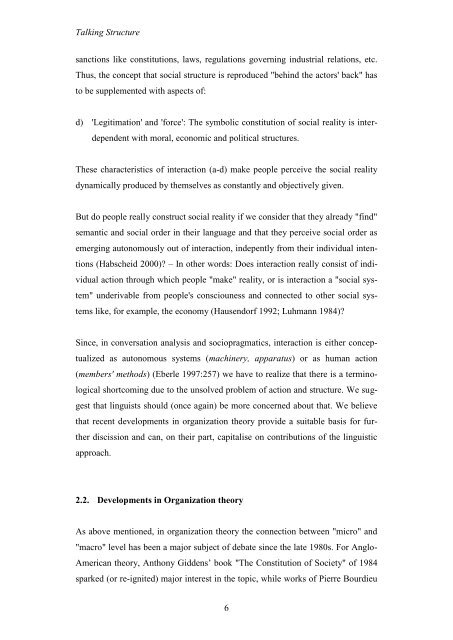In organisation theory, bridging the gap between „micro“ and „macro ...
In organisation theory, bridging the gap between „micro“ and „macro ...
In organisation theory, bridging the gap between „micro“ and „macro ...
You also want an ePaper? Increase the reach of your titles
YUMPU automatically turns print PDFs into web optimized ePapers that Google loves.
Talking Structure<br />
sanctions like constitutions, laws, regulations governing industrial relations, etc.<br />
Thus, <strong>the</strong> concept that social structure is reproduced "behind <strong>the</strong> actors' back" has<br />
to be supplemented with aspects of:<br />
d) 'Legitimation' <strong>and</strong> 'force': The symbolic constitution of social reality is inter-<br />
dependent with moral, economic <strong>and</strong> political structures.<br />
These characteristics of interaction (a-d) make people perceive <strong>the</strong> social reality<br />
dynamically produced by <strong>the</strong>mselves as constantly <strong>and</strong> objectively given.<br />
But do people really construct social reality if we consider that <strong>the</strong>y already "find"<br />
semantic <strong>and</strong> social order in <strong>the</strong>ir language <strong>and</strong> that <strong>the</strong>y perceive social order as<br />
emerging autonomously out of interaction, indepently from <strong>the</strong>ir individual inten-<br />
tions (Habscheid 2000)? – <strong>In</strong> o<strong>the</strong>r words: Does interaction really consist of indi-<br />
vidual action through which people "make" reality, or is interaction a "social sys-<br />
tem" underivable from people's consciouness <strong>and</strong> connected to o<strong>the</strong>r social sys-<br />
tems like, for example, <strong>the</strong> economy (Hausendorf 1992; Luhmann 1984)?<br />
Since, in conversation analysis <strong>and</strong> sociopragmatics, interaction is ei<strong>the</strong>r concep-<br />
tualized as autonomous systems (machinery, apparatus) or as human action<br />
(members' methods) (Eberle 1997:257) we have to realize that <strong>the</strong>re is a termino-<br />
logical shortcoming due to <strong>the</strong> unsolved problem of action <strong>and</strong> structure. We sug-<br />
gest that linguists should (once again) be more concerned about that. We believe<br />
that recent developments in organization <strong><strong>the</strong>ory</strong> provide a suitable basis for fur-<br />
<strong>the</strong>r discission <strong>and</strong> can, on <strong>the</strong>ir part, capitalise on contributions of <strong>the</strong> linguistic<br />
approach.<br />
2.2. Developments in Organization <strong><strong>the</strong>ory</strong><br />
As above mentioned, in organization <strong><strong>the</strong>ory</strong> <strong>the</strong> connection <strong>between</strong> "micro" <strong>and</strong><br />
"macro" level has been a major subject of debate since <strong>the</strong> late 1980s. For Anglo-<br />
American <strong><strong>the</strong>ory</strong>, Anthony Giddens’ book "The Constitution of Society" of 1984<br />
sparked (or re-ignited) major interest in <strong>the</strong> topic, while works of Pierre Bourdieu<br />
6














